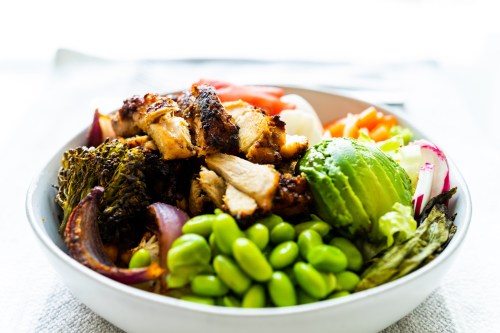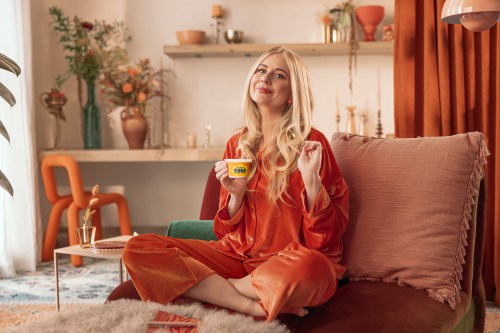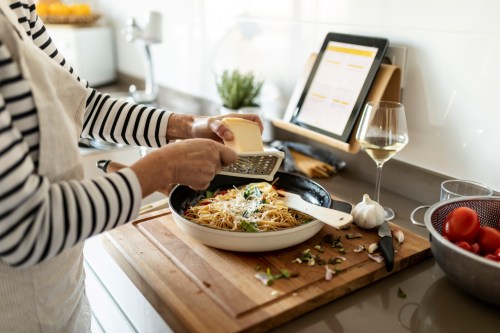Here’s What You Should Know Before You Try That Viral Recipe for 2-Ingredient Vegan Chicken
TikTok two-ingredient vegan chicken is made from flour and water. Here's what happened when I made it, plus what a nutritionist thinks.

Currently, there’s a trend making its way around the internet that is equal parts strange and intriguing to us. It involves making vegan chicken from just two ingredients—flour and water—and begs a few questions: Does it really taste good? How do you cook it, and how do you use it? Would a registered dietitian or nutritionist approve it as a healthy meat substitute?
Experts in This Article
registered dietitian and nutritionist
registered dietitian nutritionist and founder of Nutrition Con Sabor
In effect, flour-and-water chicken is a somewhat more accessible term for seitan, or wheat gluten, a relatively common vegan protein. It’s made, as TikTok has detailed, by “washing” flour with water until most of the starch is removed from the mixture, leaving behind only the gluten—the main storage protein in flour. Its texture is what makes it particularly popular—whereas many other vegan meat substitutes (like tofu) have a mouthfeel that is much softer and less dense than animal protein, this combo seems to be a more believable substitute.
Being curious, I tried making two-ingredient chicken myself
Be warned: This is not a project for the faint of heart, and takes a lot more effort than simply mixing together some flour and some water. For starters, you’re actually working with a lot of flour. The recipe I used called for a whopping eight cups of the stuff, plus three cups of water. While the first few steps seem straightforward enough (you’re just mixing the two ingredients and letting them rest for an hour), the next part requires quite a bit of work.
In order to truly “wash” the flour and rid it of its starches, you have to do a lot of kneading. For folks accustomed to bread making, this may be a bit less of a hassle (though compared to traditional breads, you’ll be significantly overworking this dough). But if you’re unaccustomed to wringing out dough, get ready for an arm workout.
After the mixture is thoroughly kneaded, you’ll go through another shorter resting phase, some seasoning, and finally, some knotting (this helps keep the lump of wheat gluten together so that you’re not just working with a messy mass).
Seitan must be cooked, and cooked well, before being eaten, and some recipes (like the one I used), suggest both sautéing and simmering it with additional spices in order to get a texture that closely resembles pulled chicken. If you forgo the simmering process, you’ll have more of a sautéed chicken end result—so go where your recipe takes you.
There are certainly pros and cons to two-ingredient chicken. Given that it takes on the flavor of whatever it’s cooked with (or the spices that you add during the initial creation process), it’s a highly versatile source of protein that is truly customizable to your unique taste preferences. It’s also good for the planet given that it requires no animal product, and can be substituted in a wide range of dishes. However, I am not (and have never been) the biggest fan of the texture of seitan. While there are certain store-bought varieties that manage to mimic the texture of meat and are generally pleasant, I found that my homemade version was a bit more doughy. This is likely the result of insufficient kneading on my part. (See, I told you it was a lot of work.)
But personal preferences aside, the question remains—is there really a health benefit to making your own vegan chicken?
Given the high-protein content, nutritionists say that two-ingredient chicken really can be a reasonable meat replacement. “Seitan is high in protein and low in calories and fat,” says Keri Gans, a registered dietitian nutritionist. And if you’re making it yourself, she adds, you can avoid adding all the additional sodium that tends to come in store-bought kind. “Seitan can help people who avoid chicken for ethical or environmental reasons still get some protein while making similar style dishes that would otherwise contain animal protein,” adds registered dietitian nutritionist Krista Linares.
Just note that seitan is not for everyone: “Given that it is 100% gluten, folks with celiac disease or a gluten intolerance would not be able to eat it,” Gans says.
So if you’re looking for a project in the kitchen, making two-ingredient chicken to your own liking could be a great way to spend a few hours. But as for whether or not it’ll be a recurring star in my own kitchen, the answer, alas, is most likely no.
Oh hi! You look like someone who loves free workouts, discounts for cult-fave wellness brands, and exclusive Well+Good content. Sign up for Well+, our online community of wellness insiders, and unlock your rewards instantly.










